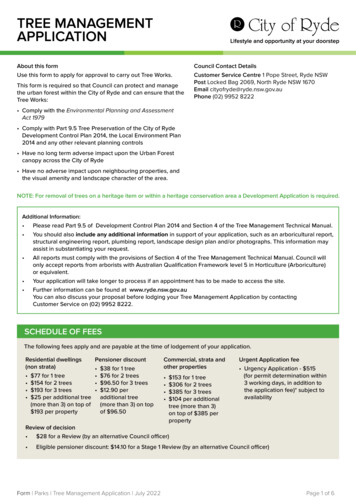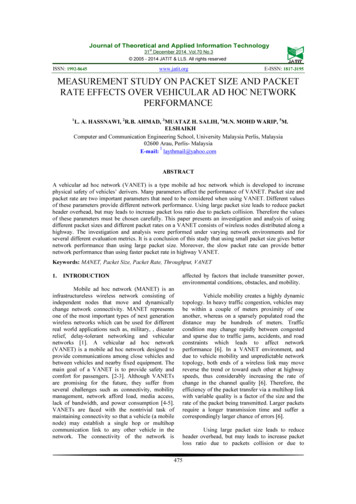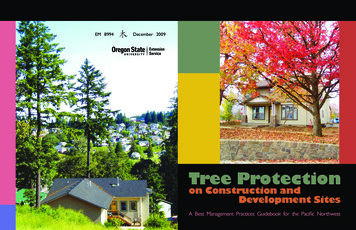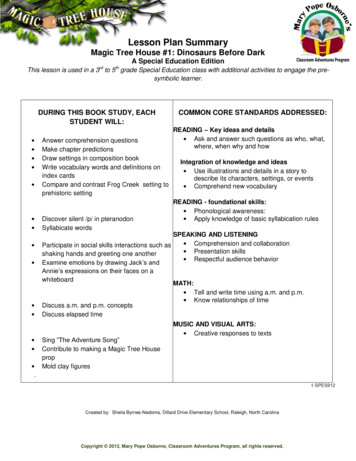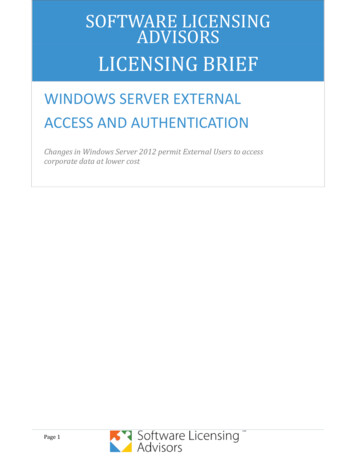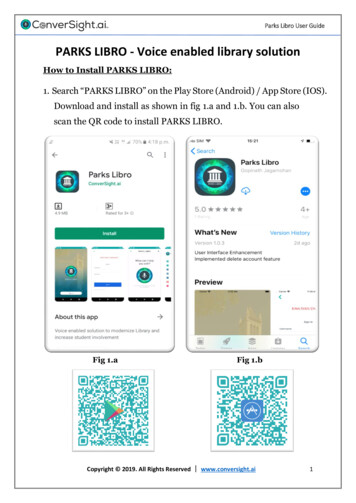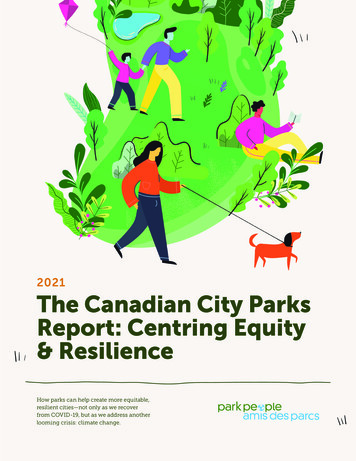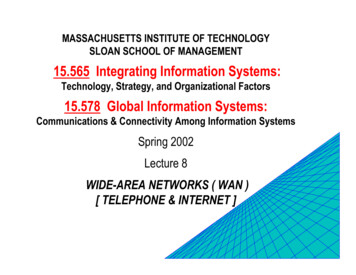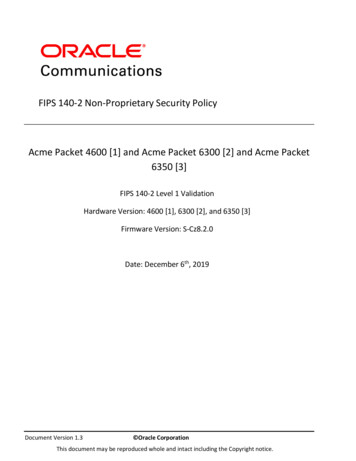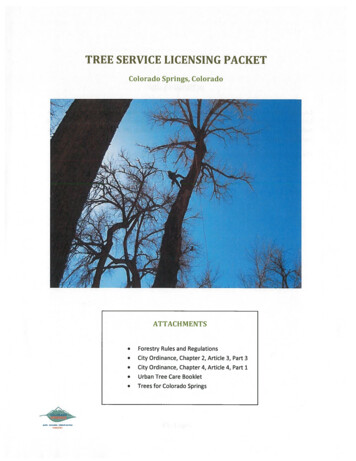
Transcription
TREE SERVICE LICENSING PACKETColorado Springs, ColoradoATTACHMENTS— — —— Forestry Rules and Regulations City Ordinance, Chapter 2, Article 3, Part 3 City Ordinance, Chapter 4, Article 4, Part 1 Urban Tree Care Booklet Trees for Colorado Springs
INTRODUCTIONCity Code states that a person or business paid to cut, train, prune, shape or remove trees in ColoradoSprings is required to have a tree service business license. (1968 Code §5-64C; Ord. 75-164; Ord. 95-42;Ord. 01-42) For purposes of tree service licensing, a tree is defined as any woody plant which is fifteenfeet (15’) or higher including conifers.The city forester must examine all tree service candidates before a business license is issued.Page 2of8
The following instructions will lead you through the tree service licensing process step-by-step.STEP 1: PICK UP AN APPLICATIONPick up a tree service business licensing application at the City Clerk’s office, Suite 101, 30 5. NevadaAye, Colorado Springs, CO 80903. The person successfully completing the written exam will be aLicensed Representative for the business where they work. If that person leaves the business, thebusiness must have a different person test to be a licensed representative.STEP 2: FILE THE APPLICATIONComplete the business license application, pay application fees, and get a receipt. KEEP THE RECEIPT!The receipt is required to take the City Forester exam.STEP 3: SCHEDULE THE EXAMINATIONCall City Forestry at 719-385-5942 to schedule a time to take the written, tree ID and pruningcompetency examinations with the City Forester’s office. It is usually best to complete all three sectionsin the same day. The exam fee is 120 and is payable by cash or check pjjy to Colorado SpringsForestry Department.Page 3 of
STEP 4: PREPARE FOR THE EXAMSThe written examination covers: Forestry Rules and Regulationsapplicable City Ordinancesarboriculturemajor insects and diseases of treessafetygeneral information pertaining to tree careplant health carepruningThe competency pruning examination covers: common climbing knotspre-climb inspection personal protective equipment (i.e. gloves, ear protection, eye protection, hardhat, etc.)work zone safety equipment (i.e. cones, signs)pruning and climbing technique (i.e. risk reduction, clearance, and tree health, completecleanup of the site and disposal of any tree debris)Resources & InformationIt’s a good idea to study all the contents of this packet, including Forestry Rules and RegulationsCity Ordinance, Chapter 2, Article 3, Part 3City Ordinance, Chapter 4, Article 4, Part 1Urban Tree Care BookletStreet Tree ListPage 4 of 8
Useful Websites:Professor Ed Gilman, University of Florida http://hort.ifas.ufl.edu/woody/pruning.shtmlThis website covers all aspects of arboriculture and pruning.Colorado Tree Coalition http://www.coloradotrees.org/This website covers community forestry in Colorado and is an excellent resource for continuingeducation opportunities in arboriculture. Resources are available for sale too.GreenCo http://greenco.org/This website covers all aspects of landscape care and best management practicesCSU Extension https://extension.colostate.edu/topic-a reas/yard-ga rden/Fact sheets on insects, diseases, trees and shrubs can be viewed and printed.International Society of Arboriculture http://www.isa-arbor.com/Society of Municipal Arborists http://www.urban-forestry.com/Useful Books and Ptthlications:Several helpful fact sheets and bulletins are available for purchase at the El Paso County CSU ExtensionOffice, 301 5. Union Blvd., Colorado Springs, CO 80910, Phone: (719) 520-7690.You may be able to view books and publications free of charge at your local library, or at the ISA RockyMountain Chapter (ISA-RMC) office 6050 Greenwood Plaza Blvd. Suite 130, Greenwood Village, CO80111, Phone: (303) 756-1815).Page 5 of 8
“An Illustrated Guide to Pruning”by Ed GilmanWell written and easy to understand, An ILLUSTRATED GUIDE TO PRUNING, is amust-have for anyone interested in the pruning and maintenance of trees.Filled with illustrations, photographs, and examples, this guide is designed tohelp readers understand and implement the appropriate pruning practices thatare vital to developing sustainable structure in the first 25 years of a tree’s life.Includes a variety of information about the challenges associated with pruningsuch as disease prevention, root pruning, mature tree pruning, and restorationfollowing storms. With its simple tables, lists, and strategies, this book is anappealing resource for horticulture, landscape and tree associations andindustries and is a natural addition for botanic garden and arboreta bookstores.“A New Tree Biology: Facts, Photos and Philosophies on Trees andTheir Problems and Proper Care”by Alex Shigo, 19864\f TREE BIOLOGYFACTS FSOT3S 4.%t HflOSOF%1 0%Ft R’FMS SAPIe:.4:An authoritative book on arboricultural practices, Alex Shigo’s “A NewTree Biology” includes discussion of his research that led to the discoverythat trees have ways of walling off decaying tissues. This led to\.*1.reassessment of arboricultural practices such as pruning techniques andcavity treatments, which showed that many of these actually promoteddecay or were ineffective. The ANSI A-300 Pruning Standard reflects hisrecommendations.Insects and Diseases of Woody Plants in the Central Rockiesby W. Cranshaw, Cooperative Extension; D. Leatherman, B. Jacobi, and L. MannixThis publication is the first to integrate insects, plant pathogens and other“varmints” associated with trees and shrubs in the Rocky Mountain region,or anywhere else in North America. It includes descriptions of organisms,diagnostic keys, and over 500 color photos. Also featured is theidentification and life history of insects, plant pathogens, vertebratescommonly associated with trees and shrubs, and a discussion of abioticdisorders. This is Colorado State University Bulletin 506A and is available idprod uct 1 and atother locations.Page 6 of 8
STEPS: TEST DAYOn the day of you exam, arrive on time with all the materials you will need to take the exams:Receipt showing proof of payment of application fees for your business license Personal protective equipment (i.e. gloves, ear protection, eye protection, hardhat, etc.) Work zone safety equipment (i.e. traffic cones, signs)Work equipment (i.e. saws, pruners, etc.)STEP 6: WRITTEN EXAMThe written examination covers: Forestry Rules and Regulations applicable City Ordinancesarboriculture major insects and diseases of treessafetygeneral information pertaining to tree careplant health care pruningDetails of the written examination: There are fifty questions on the test.A passing grade on the written exam is seventy-five percent (75%).The applicant may take a second written examination if the first attempt was unsuccessful.The applicant must wait six (6) months to retake the exam if a failing grade is received on thefirst two attempts on the written examination.STEP 7: TREE INDENTIFICATION EXAMApplicant will be asked to identify 25 common trees by common name. Specimens may be live trees ormounted. A passing grade is 75%.STEP 8: COMPETENCY PRUNE EXAM A test tree of sufficient size and character is selected to test the applicant’s pruning skills.The City Forester or designee must be present when the applicant begins pruning the test tree.Applicant will demonstrate common climbing knots, pre-climb inspection, personal protectiveequipment (i.e. gloves, ear protection, eye protection, hardhat, etc.), work zone safetyequipment (i.e. cones, signs), and pruning and climbing technique.Page 7of8
The pruning objectives may include risk reduction, clearance, and tree health and includescomplete cleanup of the site and disposal of any tree debris.The test prune must be completed within thirty (30) days after passing the written test. Apassing grade is 75%.The City Forester or designee will review the tree upon completion for technical competence.Should the City Forester or designee approve the test prune, the applicant will be recommendedfor license issuance. Should the City Forester or designee reject the test prune, the applicant may make anycorrective pruning necessary after the Forester reviews the reasons for rejection with theapplicant. Should the City Forester or designee reject the corrective pruning of the test tree, the applicantwill be asked to prune another tree. The same procedure will be followed for the secondcompetency test prune.STEP 9: CITY FORESTER’S APPROVALThe City Forester shall authorize issuance of a tree service business license by the City Clerk’s Officeafter the applicant successfully passes the written and practical exams or furnishes evidence of previoussatisfactory experience as the City Forester’s professional judgment deems proper.The City Licensing Clerk will be notified of the City Forester’s recommendation.APPENDIXCITY CONTACTSCity Forestry Office385-59421421 Recreation Way, upstairs in the 2-story concrete buildingCity Clerk’s Office385-590130 S Nevada Aye, Suite 101City Planning385-5905For hillside overlay and preservation easement questionsPage 8 of 8
Forestry Rules andRegulationsLicensed Tree Service ProceduresAndTree Maintenance Standards and Specifications(In Accordance with City Code §2.3.307)parksculiuralrvrcForestry Division(719) 385-5942FORESTRY RULES AND REGULATIONS, 2006Page 1
Table of ContentsPurposeII.Ill.IV.V.DEFINITIONSA. City Forester’s PermitB. Front Yard Setback TreesC. Park TreeD. ParkwayE. Right- Of-WayF. Street TreesAreas of ResponsibilityA. Street TreesB. Private TreesC. Park TreesD. Front Yard Setback TreesE. Hard Stirfacing Street Trees in Right-of-WaysTree Service LicensingA. Licensing Processa. Application and Testing Procedureb. Written Examinationc. Competency Pruned. City Forester’s Reviewe. City Forester’s ApprovalB. Responsibilitiesa. City Clerk’s Officeb. City forester’s Officec. Licensee ResponsibilityC. Conduct of Operations for tree Pruning/RemovalTree Maintenance StandardsA. Planting Standardsa. General Requirementsb. Tree planting requirementsc. Planting SpecificationsB. Tree Pruning Standardsa. General requirementsb. Specific Requirementsc. Pruning Best Management Practicesd. Requirements for line clearanceC. Pest Control StandardsD. Tree Preservation Standardsa. General Requirementsb. Tree preservation specificationsE. Disease and Nuisance TreesF. Private Property RequirementsSignificant Tree ProgramA. ApplicationB. ApplicabilityC. Significant Trees Are Those That AreD. Significant Tree DesignationE. Significant Tree RosterF. Special Care and ProtectionG. Designation Procedure For Significant TreesH. Threatened Significant Tree ProcedureFORESTRY RULES AND REGULATIONS, 20063333333222222Page 2
PurposeIn an effort to foster sound arboricultural practices within the urban forest, these Forestry Rules andRegulations, unless otherwise specified, shall apply to all trees and urban forest vegetation within Cityon private and public property. The Forestry Rules and Regulations supplement the requirements of thecode of the City of Colorado Springs 2002, as amended. Authorization in the City Code for these Rulesand Regulations is cited in parenthesis where appropriate. These Forestry Rules and Regulations arepromulgated in accord within City Code §2.3.307.I.II.Definitionsa.CITY FORESTER’S PERMIT: For any public tree (including Right-of-way) a permit form, signedby the City Forester or designee, authorizing pruning, spraying, removal, root pruning,planting, and any other general tree work.b.FRONT YARD SETBACK TREES: For purposes of street tree planting, a Front Yard SetbackTree is a tree planted in the area between five (5) and ten (10) feet from an attachedsidewalk and eight (8) to ten (10) feet from the curb where there is no sidewalk. A treeplanted in the Front Yard Setback is not necessarily in the right-of-way and may be private.c.PARK TREES: Trees situated in public parks, cemeteries, golf courses, medians, and all otherareas owned by the City to which the public has access.d.PARKWAY: A parkway is the area between the sidewalk and the curbe.RIGHT-OF-WAY: The area of land designated for streets, sidewalks, and public use. Itincludes the area between sidewalks and curbs. Where sidewalks are attached to curbs, theright-of-way usually extends a distance into the property. The exact distance varies fromstreet to street.1.STREET TREES: Trees situated on the public right-of-way between the curb or edge of roadand adjoining property line along public streets, avenues, or ways within the City. Thisincludes trees in the parkway.AREAS OF RESPONSIBILITYa.STREET TREES: Generally, street trees are the responsibility of the landowner.b.PRIVATE TREES: Private trees are the responsibility of the landownerc.PARK TREES: Park trees are the responsibility of the Parks and Recreation Departmentd.FRONT YARD SETBACK TREES: Front Yard Setback trees, which are situated in the publicright-of-way, are the responsibility of the Parks and Recreation Department to spray,prune, or remove. Front yard Setback trees situated on private property are theresponsibility of the adjacent property owner. In either situation, watering andfertilization are the responsibility of the property owner.FORESTRY RULES AND REGULATIONS, 2006Page 3
e.HARD SURFACING-STREET TREES IN RIGHT-OF-WAYS: A permit is required from the CityForester for impervious hard surfacing around trees in public right-of-way (City Code§4.4.1OSC). Additionally, a permit is required from City Engineering for all concrete inthe right-of-way. No permits are required for pervious materials like payers, flagstone,or rock mulch.Hard-Surfacing Specifications(for 4” parkways or greater)Parkways with trees (cover root zone with mulch)Parkway Width (feet)Minimum Opening for Trees (feet)44x655x766x877x988x1099x111010x12Parkways without trees (leave cut-out for future trees)Parkway Width (feet)Minimum Opening for Trees (feet)44x655x766x877x988x1099x111010x12III.Tree Service Licensing (City Code §2.3.301 et. Seq.)A. LICENSING PROCESS1)Application an Testing Procedurea.Pick up the tree service licensing forms at the City Clerk’s Office. A Tree Service Business Licenseis required for any individual or business which advertises for and/or engages in the cutting,training, pruning, shaping, or removing of trees fifteen feet (15”) or taller for hire. A LineFORESTRY RULES AND REGULATIONS, 2006Page 4
Clearance License is required for anyone cutting, training, pruning, shaping or removing treesunder or adjacent to electric utility lines pursuant to a contract with Colorado Springs Utilities.b.Applicant must complete a tree service business license application obtained from the CityClerk’s Office. Evidence of general liability insurance must be furnished prior to payingappropriate fees.c.Schedule the written and competency examinations with the City Forester’s Office (bring thebusiness license receipt showing proof of payment of application fees).Schedule the written and competency examinations with the City Forester’s Office (bring thebusiness license receipt showing proof of payment of application fees).U.e.The owner of the business or employee of the business successfully completing theexaminations will be the Licensed Representative of the business.f.After passing the written examination, a competency prune and tree identification test arerequired.g.The applicant and the Deputy Licensing Officer will be notified of the City Forester’srecommendation.2. Written Examination and Tree Identification Testa.The written examination covers all Forestry Rules and Regulations, appropriate City Ordinances,major insect and diseases of trees, and general information pertaining to tree care.b.A passing grade on the exam is seventy-five percent f 75%).c.A second written examination may be taken by the applicant if the first attempt wasunsuccessful.d.The applicant must wait six (6) months to retake the exam if a failing grade is received on thefirst two attempts on the written examination.e.A Tree Identification Test will be given after the applicant passes the written examination.3. Competency Prunea.A test tree is selected and shall be of sufficient size and character to test the applicant’s pruningskills.b.The City Forester or designee must be present when the applicant begins pruning the test tree.c.The date and time to prune the test tree will be arranged by mutual agreement between theapplicant and the City Forestry Office.d.The pruning must adhere to specifications as outlined herein, and includes complete cleanup ofthe site and disposal of any tree debris.FORESTRY RULES AND REGULATIONS, 2006Page 5
e.The test prune must be completed within thirty (30) days after passing the written test.4. City Forester’s Reviewa.The City Forester or designee will review the tree upon completion for technical competence.b.Should the City Forester or designee approve the test prune, the applicant will be recommendedfor license issuancec.Should the City Forester or designee reject the test prune, the applicant may make anycorrective pruning necessary after the forester reviews the reasons for rejection with theapplicant.d.Should the City Forester or designee reject the corrective pruning of the test tree, the applicantwill be asked to prune another tree. The same procedure starting at 3(a) through 4(c) will befollowed for the second competency test prune.e.Should an applicant fail to satisfy the City Forester or designee on the second test prune, theapplicant must wait six (6) months to reapply.5. City Forester’s ApprovalThe City Forester shall authorize issuance of a tree service business license by the City Clerk’s Officeafter the applicant successfully passes the written and practical exams or furnishes evidence ofprevious satisfactory experience as the City Forester’s professional judgment deems proper. (CityCode §2.3.303)B. RESPONSIBILITIES1.2.City Clerk’s Officea.The Deputy Licensing Officer in the City Clerk’s Office verifies and monitors insurancerequirements of tree service businesses.b.The Deputy License Officer directs each applicant for a tree service business license to theCity Forester for reviewc.The deputy Licensing Officer issues tree service business licenses, subsequent licenserenewals, revocations/suspension notices, cease and desist notices and collects allappropriate fees.d.The Deputy Licensing Officer is responsible for enforcement of the City Code as set forth inCity Code § 2.1.201 et. Seq.City Forester’s Officea.The City Forester or designee examines each applicant for such license, either orally or inwriting, or both, covering the applicant’s qualifications and competence. A practicaldemonstration of ability and competence in the tree service business or the furnishing ofFORESTRY RULES AND REGULATIONS, 2006Page 6
3.b.satisfactory experience is also required before a recommendation for the issuance of a treeservice business license is made to the Deputy Licensing Officer.c.The City Forester may request the initiation of suspension or revocation proceedings to theDeputy Licensing Officer for violations of the Forestry Rules and Regulations (City Code§2.3.306).d.The City Forester may initiate or conduct investigations pertaining to violations of theForestry Rules and Regulations.License Responsibilitya.The tree service business shall be responsible for performing all tree work in conformityto the Forestry Rules and Regulations; exceptions must be approved by the CityForester.b.The tree service business shall obey any and all applicable Statutes of the State ofColorado and adhere to the Code of the City of Colorado Springs 2001, as amended.c.The tree service business must maintain with the City Clerk’s Office a current mailingaddress. Any notice and order, or other related communication, whether delivered bypersonal service or by certified, registered, or first class mail sent to that address, shallconstitute service.C. CONDUCT OF OPERATIONS FOR TREE PRUNING/REMOVAL1) Authorization to conduct tree service work in the City neither expresses nor implicitlycreates a right to violate any law while in progress of performing tree service work.2)All work shall be conducted in a manner to cause the least possible interference with, orannoyance, to others.3)Inadequate or improperly trained personnel shall not be utilized for work on treesbeyond the person’s known capacity or ability to perform properly or safely.4) A supervisor shall be present at all times when work is being performed, except thesupervisor may be absent for short periods during the day when necessary because ofemergency or other urgent matters.5)Any injury to persons or damages to any utility, improvement, tree, or structure locatedupon or underneath any public street or public right-of-way resulting from anypermitted work shall be promptly reported to the City Forester and arrangements madeto make restitution or repair within a reasonable period of time.6) Cleanup of branches, logs, or any other debris resulting from any tree operations shallbe promptly and properly accomplished. The work area shall be kept safe at all timesuntil the cleanup operation is completed. Under no circumstance shall the accumulationof brush, limbs, logs, or other debris be allowed on a public right-of-way in a mannerwhich results in a hazard to the public.FORESTRY RULES AND REGULATIONS, 2006Page 7
7) Any use of tools or equipment in an unsafe condition or any application of techniques ormethods deemed unsafe to persons or property is prohibited.8) Any use of climbing spurs in the act of pruning trees is prohibited.9) Tree workers shall not leave the work site if any severed or partially cut limbs remain intree.10) Pedestrian and vehicular traffic shall be allowed to pass through work areas only underconditions of safety and with as little convenience and delay as possible.11) Adequate Street and sidewalk barricades, warning devices and personnel shall be placedas specified in the manual on Uniform Traffic Control Devices which can be reviewed atthe City Traffic Engineer’s Office.12) Whenever large tree sections are being cut in a treetop which may endanger persons orproperty, the sections shall be secured by ropes and lowered safely in a controlledmanner.13) Affixing or installing any metal materials or any other substances foreign to the naturalstructure of a street or park tree shall be done only after written permission has beensecured from the City Forester.14) Whenever electric or telephone lines, gas lines, water lines, cable lines, or any otherimprovement, public or private, will be jeopardized by any authorized tree activity, theproper authorities of the utilities involved, or property owner involved shall beconsulted prior to performing any tree work activity, and all requested reasonableprecautions by any authority or persons shall be complied with.15) Unless the tree work area is totally barricaded or otherwise kept safe, at least onerepresentative of the licensee shall serve to coordinate safe operations on the ground atall times when permitted work operations are in progress.16) All street trees shall be removed in a manner so that the remaining stumps will beground out to at least sixteen inches (16”) below the normal ground level, unless specialvariance is otherwise granted by the City Forester.17) Stump removals resulting from street tree removals must be promptly filled with cleanearth fill not to exceed eight inches (8”) in height to allow for settling, properlycompacted and free of debris, excepting small wood chips, unless special variance isotherwise granted by the City Forester.18) Street trees and utility poles shall not be tied to winch trucks in the process of removingother trees, or otherwise be used for the purpose of securing anchorage or leveragewhile removing other trees or portions thereof.FORESTRY RULES AND REGULATIONS, 2006Page 8
IV.TREE MAINTANANCE STANDARDS(Standards and Specifications for public and private trees as set forth in Chapter 4, Article4, Parts1, 2, and 3 of the City Code. References to the enabling authority are provided in parentheseswhere appropriate)PLANTING STANDARDS1.2.General Requirements: “Right-of-way”a.Street tree planting in right-of-way is a privilege allowed by the City to owners ofabutting property with the provision that the property owner or owners, thereafter,will be responsible for watering and fertilizing all plantings (City Code §4.4.105A)b.Trees shall be single-stemmed and branched no less than four feet (4’) above theground may be planted with approval of the City Forester or designee.c.Right-of-way adjoining private property shall be maintained in an aestheticallypleasing, landscaped condition. Vegetation shall be watered and fertilized toprovide optimum growing conditions (City Code §4.4.105A).d.If the adjoining property owner desires hard surfacing of the right-of-way, a writtenpermit shall be obtained from the City Forester’s Office, Parks and RecreationDepartment (City Code §4.4.105C).Tree pla nting requirements: “Right-of-way”a.Approved Street Tree Species: A listing of trees planted in the public right-of-way orwith Front Yard Setback City Planting Programs may be obtained from the CityForester’s Office.b.Variances for Non-Approved Street Trees: Non-approved street trees may beplanted in the right-of-way or Front Yard Setback after site inspection and issuanceof a City Forester’s Permit. The criteria for a variance shall be as follows:1.2.3.c.Adequate space is available for future growth of the tree.No utility or traffic hazard or will be createdTree selection is in accordance with generally accepted urban forestrypractices.Street tree spacing:1.No trees shall be planted in parkways that are less than four (4’) in width.For detached sidewalk right-of-way less than eight feet (8’), the tree shall beplanted in the center midway between the curb and sidewalk. For detachedsidewalk right-of-way greater than eight feet (8’) the tree may be plantedoffset from the centerline with approval from the City Forester.FORESTRY RULES AND REGULATIONS, 2006Page 9
3.2.Spacing between large street trees, when designated as such, shall be atleast forty feet (40’). Spacing between small trees, when designated as such,shall be approximately thirty feet (30’). Spacing must provide for andconform to the mature growth of the species involved (City Code4.4.101C).Variances may be granted by the City Forester.3.In order to avoid corner visibility obstructions, new trees shal not be plantedcloser than forty feet (40’) from a street corner. On corner lots, no plantings,except trees noted herein, may exceed thirty inches (30”) at mature heightabove the curb across the corner area. The corner area is determined bymeasuring fifty- five feet (55’) from the curb line along each street. The two(2) points are connected by a diagonal line creating a triangle. The triangularspace, or “Corner Visibility Triangle”, must be kept free of obstructions sotraffic visibility is not obscured (City Code7.4.102G).4.Where the sidewalk and curb are one unit (attached), the tree shall beplanted in the right-of-way at least five feet (5’) from the sidewalk edgeadjacent to the property line. Where the sidewalk and curb are attached,street trees planted by Certificate or along public streets where the right-ofway is limited, shall be planted in the Front Yard Setback. Some treesplanted in the Front Yard Setback may end up on private property whereasthey become private trees. Prior to planting such trees, the property ownermust enter into agreement with the City where all responsibility for the treeis assumed by the property owner and the agreement runs with the land.The tree must not be removed without the permission of the City Foresteror designee.d.No tree shall be planted closer than five feet (5’) to any driveway nor shall it beplanted in such a manner that eventual growth cannot be reasonably controlled soas to avert interference with, or obstruction to, any improvements installed forpublic benefit including, but not limited to, traffic and street signs, fire hydrants,overhead utility wires, street lights, utility poles, or any other public improvements.e.Street trees on Front Yard Setback trees must be planted at least twenty feet (20’)from existing trees on private property.Pla nting Specifications: “Rights-of-Way”a. Planting Material1.Plant material shall conform to the Rules and Regulations of the Colorado NurseryAct. Plant material shall be of standard quality, true to type, and in all respects besuitable for planting and survival (i.e. hardiness) in Colorado Springs.2.3.Plants shall have normal, well-developed tops and vigorous root systems.Plants shall be free of defects, decay, and bark/cambium injuries, insects, anddiseases.FORESTRY RULES AND REGULATIONS, 2006Page 10
b. Planting Methods and Techniques1.Planting pits should be dug no deeper than the depth of the soil ball and be fiftypercent (50%) wider to aid in tree establishment.2.Soil amendments should not exceed thirty percent (30%) by volume, and inmost cases are not necessary3.Plants should be set with the crown/trunk flare at soil grade.4.Evergreens in excess of six feet (6’) in height or any tree loose in the groundshould be staked or guyed securely. Use a method of staking or guying that doesnot create a safety hazard.5.Underground electric, telephone, and cable vision lines, as well as gas lines,water lines, irrigation lines, or other improvements, public or private, should belocated prior to planting.6.Plantings should be mulched to a depth of three inches f3”)to cover the rootsystem.7.Watering wells six inches (6”) high shall be constructed for plantings in nonirrigated areas to facilitate watering.8.A four-by-four square (16 square feet) shall be the minimum planting area fortrees surrounded by “hard surfacing” (i.e., con
Springs is required to have a tree service business license. (1968 Code §5-64C;Ord. 75-164;Ord. 95-42; Ord. 01-42)For purposes of tree service licensing, a tree is defined as any woody plant which is fifteen feet (15') or higher including conifers. The city forester must examine all tree service candidates before a business license is issued.
